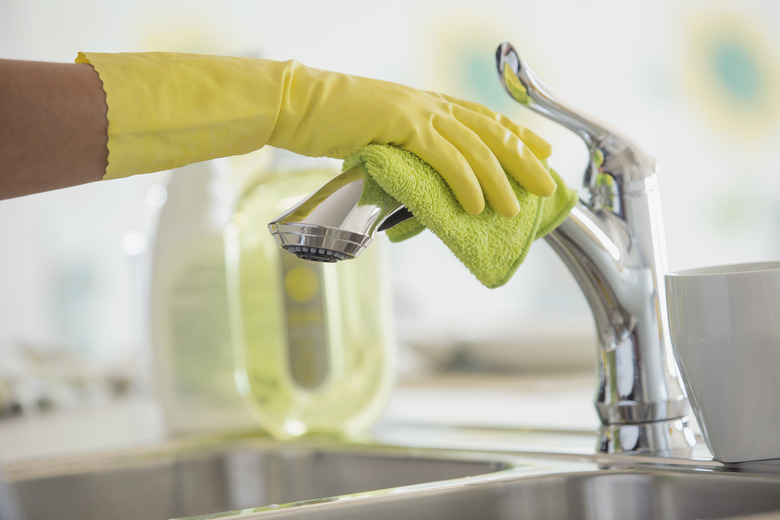How To Clean A Kitchen Sink
Kitchen sinks get notoriously dirty with food scraps from cooking dinner and washing dishes. In fact, studies show they are the germiest area in a kitchen. If you don't clean your sink on a regular basis – meaning at least weekly – you could be harboring bacteria, mildew or mold in your kitchen without even knowing it. Like many things, though, how you clean your kitchen sink will depend on the material it is constructed from.
Daily Maintenance
Daily Maintenance
No matter what kind of sink you have, remove any food debris and wipe the basin and faucet down daily with a mild dish soap and water. You'll still want to do a weekly deep cleaning based on your sink's material, as well, but this should keep the bacteria at a minimum and help maintain the finish no matter what your sink is made of.
Porcelain and Ceramic Sinks
Porcelain and Ceramic Sinks
Porcelain and ceramic are some of the most common materials used in sinks and the easiest to clean, as well. Simply wet your sink with warm water, sprinkle baking soda onto the sink and rub with a cloth or sponge until it forms a paste. The baking soda can remove stains, soap scum and food residue, as well as shine your sink. Carefully rinse the entire sink with water, making sure to remove all baking soda residue, then dry the sink with a clean cloth.
For tough stains, commercial kitchen cleansers can be used according to the manufacturer's instructions. Avoid using abrasive cleaners and steel wool to prevent scratches on the surface.
Stainless Steel Sinks
Stainless Steel Sinks
Aside from the daily cleaning with dish soap, stainless steel sinks should also be rinsed well after every use to avoid pitting as acids and salts can damage the finish. Weekly cleaning can be done using the same process as that used for porcelain and ceramic sinks. Because stainless steel is particularly prone to spotting, you may want to run a cloth soaked in vinegar along the surface as needed to remove spots.
To clean tough mineral stains, soak paper towels in vinegar and line the entire basin with the towels. Allow the towels to sit for up to half an hour, then throw them away before cleaning the sink thoroughly with soapy water to remove any vinegar residue. Dry the sink immediately to avoid creating more spots.
If you have any particularly difficult stains, you can also use a commercial stainless steel cleaner. Always follow the manufacturer's instructions when using such a cleaner, and be sure to rinse and dry the sink thoroughly afterward. Always avoid using abrasive cleaners, bleach, ammonia, steel wool or abrasive sponges on stainless steel sinks or you may damage the finish.
Cast Iron Sinks
Cast Iron Sinks
Like stainless steel, cast iron sinks should be rinsed after each use. Additionally, it can help to thoroughly dry the sink with a clean cloth after rinsing. These sinks can be cleaned with the same weekly baking soda process used for porcelain and ceramic sinks.
Abrasive cleansers should always be avoided on cast iron. It is difficult to remove set-on stains without using something that may damage the surface, so try to avoid stains in the first place. Do not leave dirty dishes in the sink for long periods of time and avoid leaving any tea bags or coffee grinds in the sink.
Copper Sinks
Copper Sinks
Although baking soda and vinegar work fine on most sinks, the patina on copper can be damaged by things as gentle as baking soda and vinegar. The good news is that a daily wash with mild dish soap is all you need for a copper sink. Its natural antibacterial properties will take care of all the germs.
Stone and Stone Composite Sinks
Stone and Stone Composite Sinks
Because stone is porous, it can absorb liquid, so acidic and chemical cleaning products should be avoided at all cost as they can easily damage the stone. Instead, use a mild dish soap and warm water to clean your sink every time you use it and pat it dry immediately.
Disinfecting Your Sink
Disinfecting Your Sink
To disinfect a porcelain, ceramic, stainless steel or cast iron sink, pour several cups of vinegar into the plugged basin. Then, dip enough paper towels into the vinegar to cover your entire sink. Once they are saturated, lay them over your entire sink, including the faucet and caulking, and leave them for 20 minutes. Next, remove the towels, throw them away and rinse your sink again with water and dish soap to remove any remaining vinegar.
Do not use vinegar on copper or stone sinks. Copper is naturally disinfecting, so as long as the sink is kept clean, you do not need to worry about additional disinfecting. To disinfect stone, purchase a commercial stone disinfectant and use according to the manufacturer's directions.
Cleaning Caulking
Cleaning Caulking
Use baking soda and a little water to make a paste and use an old toothbrush to clean the caulk seal around your sink, the faucet and the drain flaps in the bottom of the basin. Rinse your toothbrush and add new baking soda regularly because these areas can get very dirty. If you have a copper or stone sink, take care not to get baking soda on the basin. Rinse thoroughly after cleaning.
Sanitizing Drains
Sanitizing Drains
It's always a good idea to sanitize your drain at least once a month to prevent nasty germs from creeping up the pipes. To sanitize, mix 1 teaspoon of bleach with 1 quart of water and pour it down the drain. If you have anything but a porcelain or ceramic sink, you may want to use a funnel to keep the bleach from damaging the finish on your sink. This process can also be used to clean any food traps, strainers or drainers you may have, as well.
